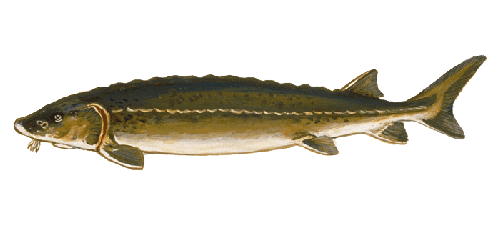
Scientific name:
Acipenser Fulvescens
Identification:
Body heavy, torpedo-shaped, angular (5-sided) in young, but round in adults. Total length of adults around 45" or more. Snout short, conical. Spiracle present. Caudal peduncle short, stout, partly naked. Lower lip with 2 lobes. Barbels on lower snout, smooth (4). Upper lobe of tail fin pointed without threadlike (filamentous) extension (compare with shovelnose sturgeon). Young gray or brown dorsally with dusky dorsal and lateral blotches. Adults gray to olivaceous dorsally, white ventrally.
Distribution:
The lake sturgeon is listed as a rare species in the United States. Over most of its range in the United States, it appears to be threatened. In Wisconsin, it is common in the Menominee River, the lower Wolf River, Lakes Poygan and Winnebago, Lake Wisconsin, the St. Croix River to Gordon Dam, Namekagon River below Trego Dam, and the Chippewa and Flambeau rivers. It is uncommon to rare in the lower Wisconsin River, Mississippi River, the Madison lakes, and Lakes Michigan and Superior. The Wisconsin Department of Natural Resources has given the species “watch” status.
Spawning:
Spawning happens around late April to May, sometimes June. Males do not reach sexual maturity until they are 20 years old, and females are usually 25 years old before they spawn for the first time. Females only spawn every 4 to 6 years, while the males usually spawn every other year. When spawning begins, several male will swim along side a female, usually going against the current. The female deposits her eggs and the males fertilize them at the same time. Each spawning act is brief, but the entire process can last up to 8 hours and can be spread out over a couple of days. A single female can lay from 50,000 to 1,000,000 eggs, depending on her size. Eggs hatch in 5-10 days depending on water temperature.
Angling: